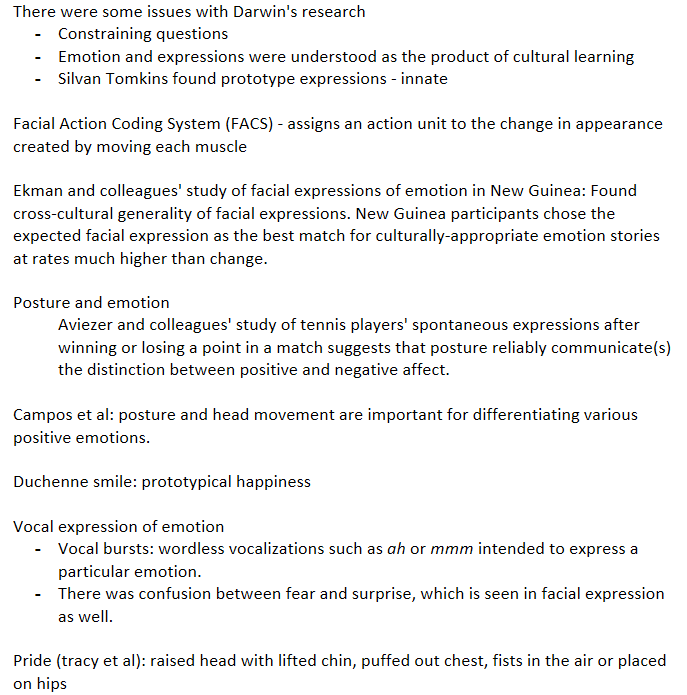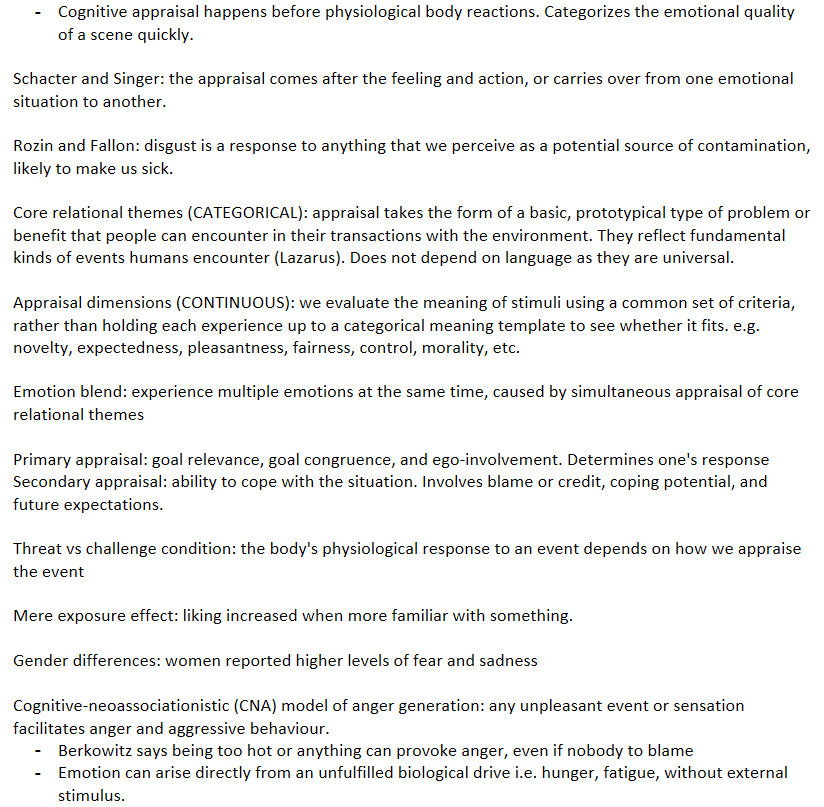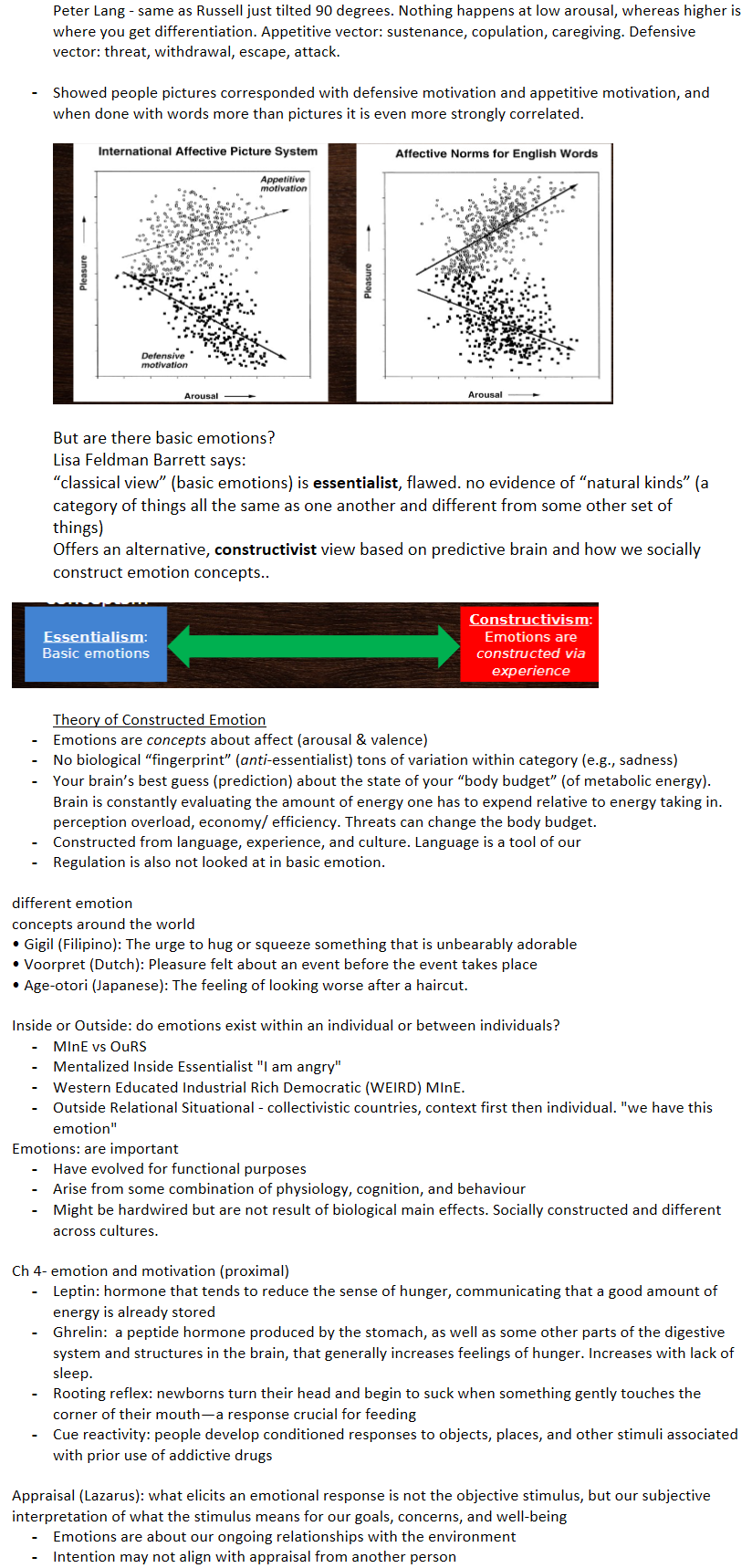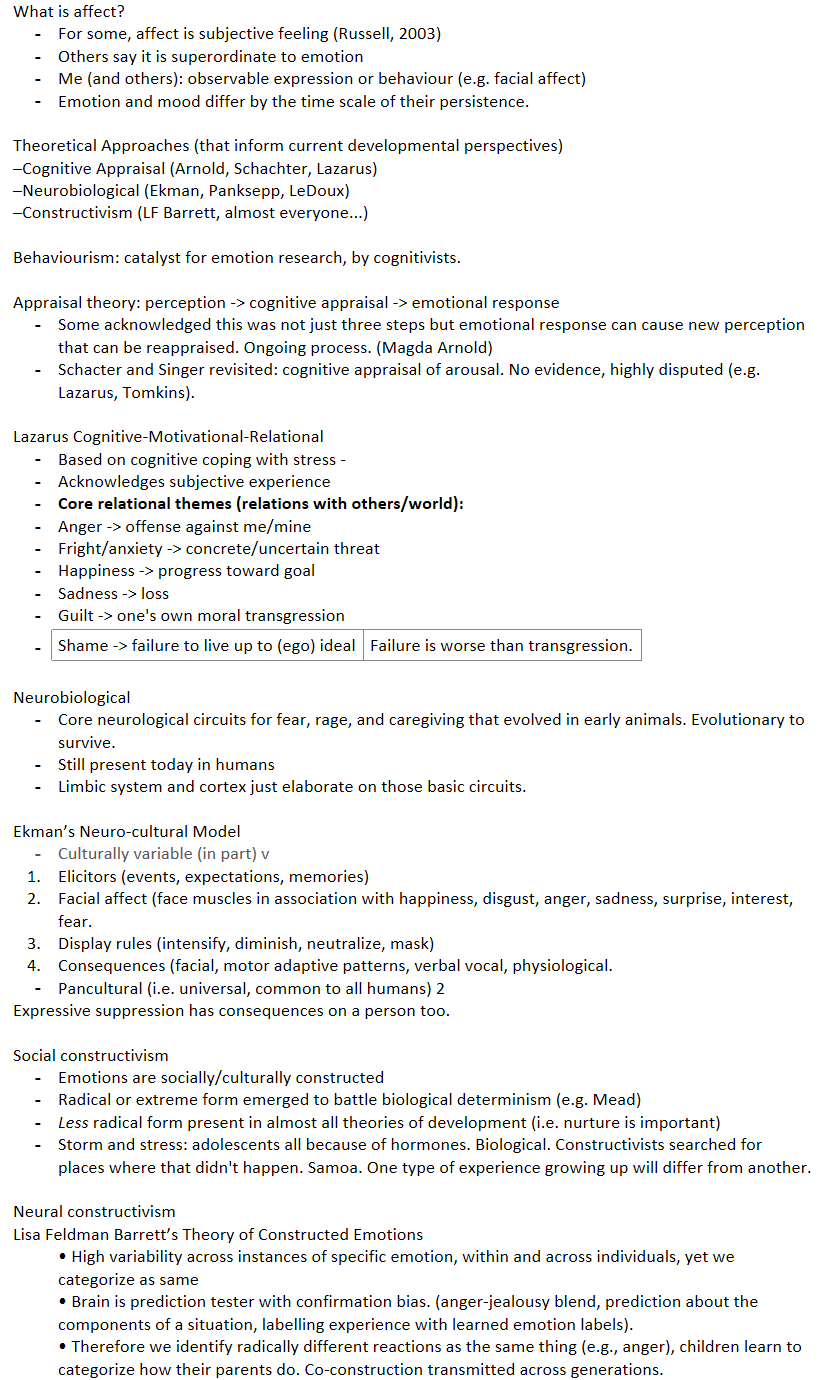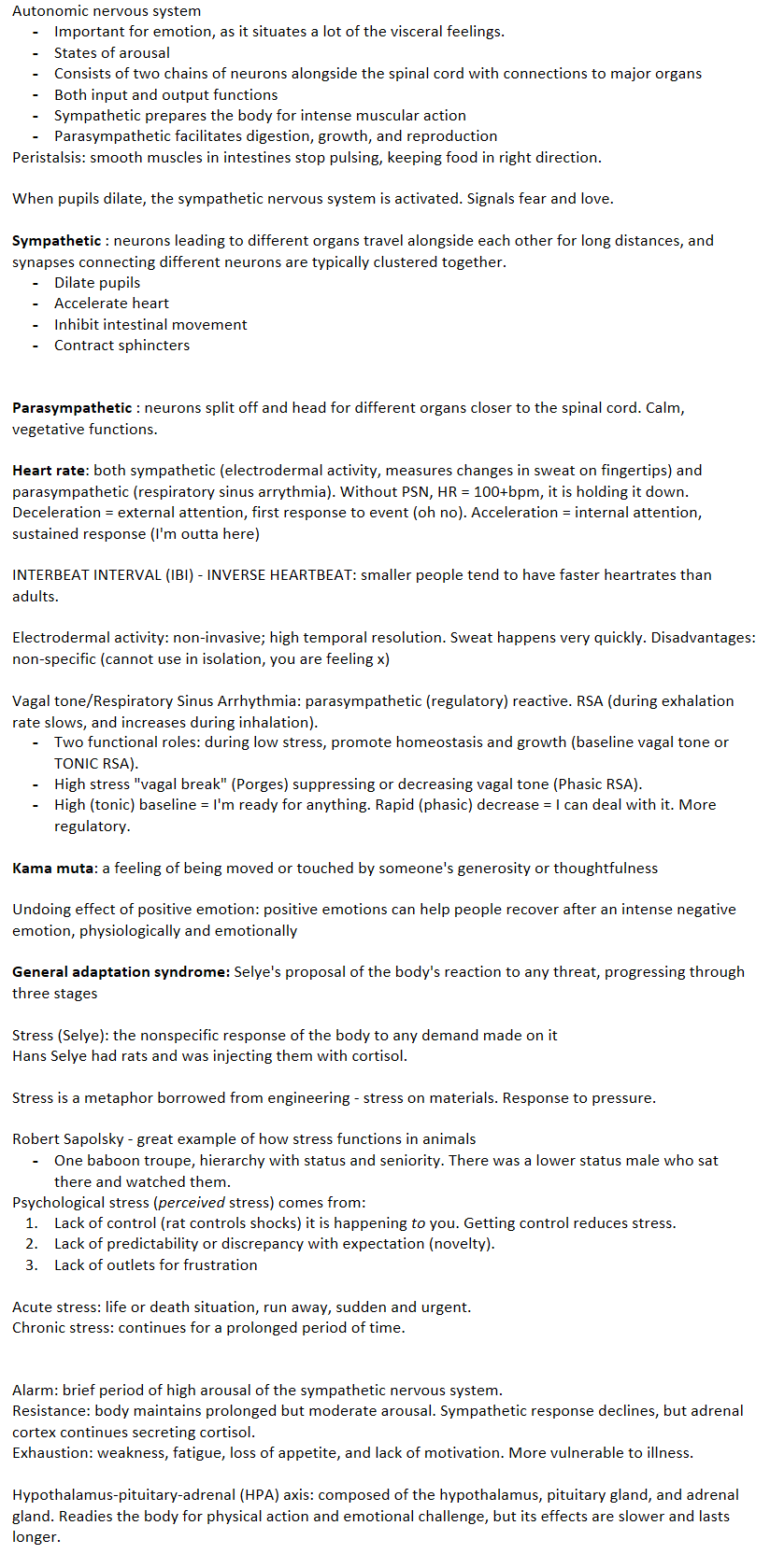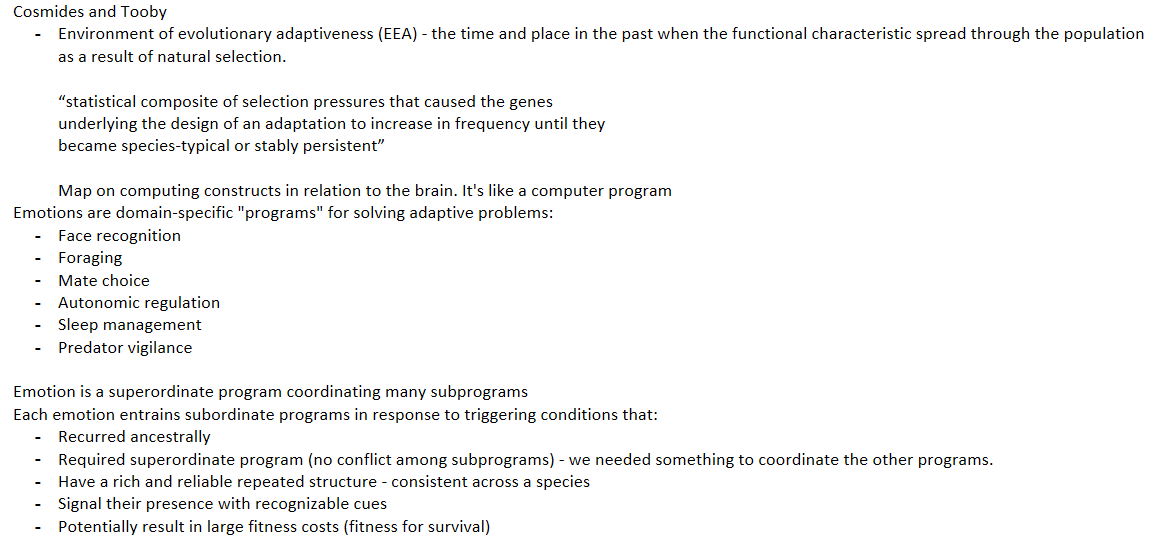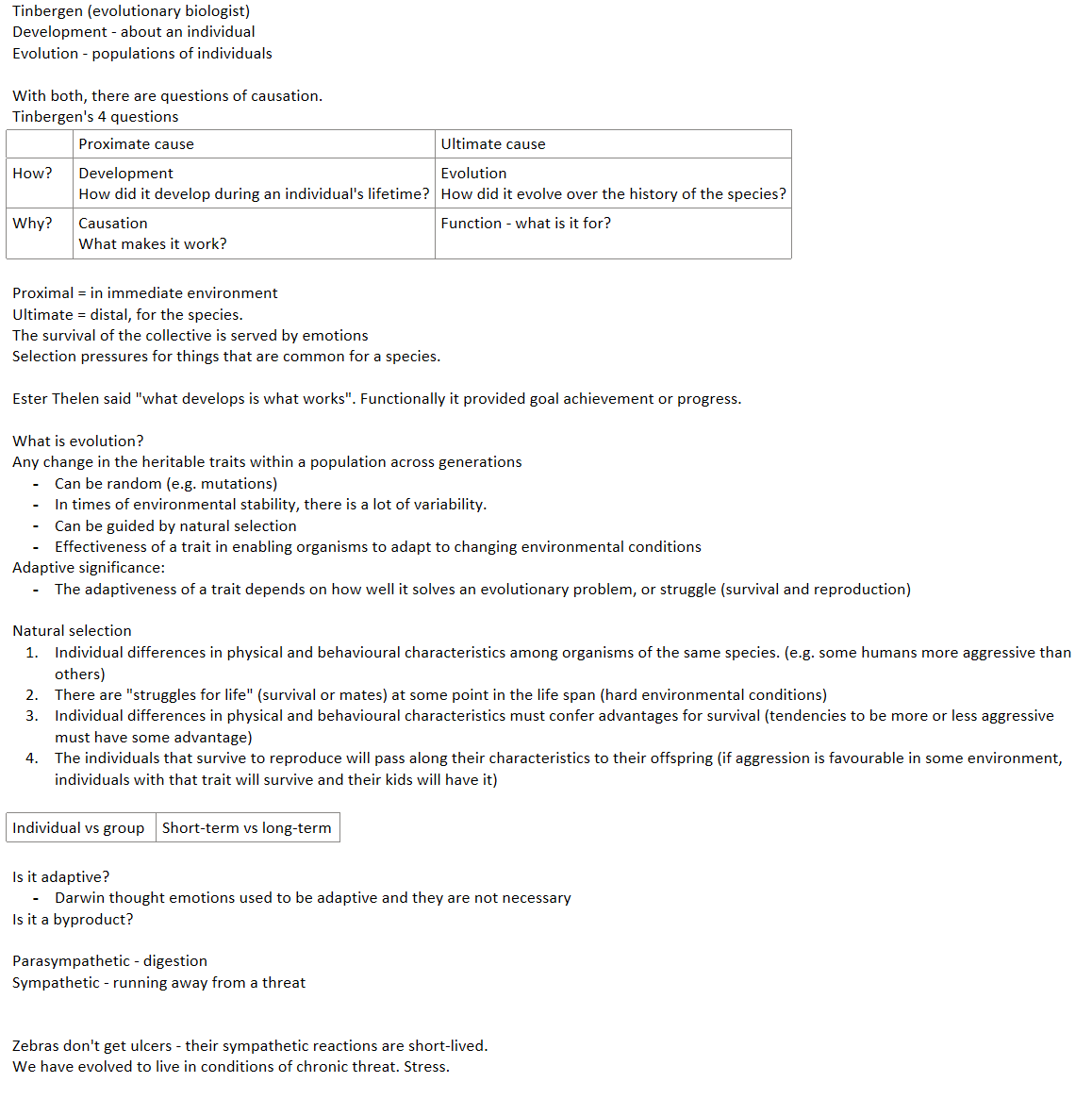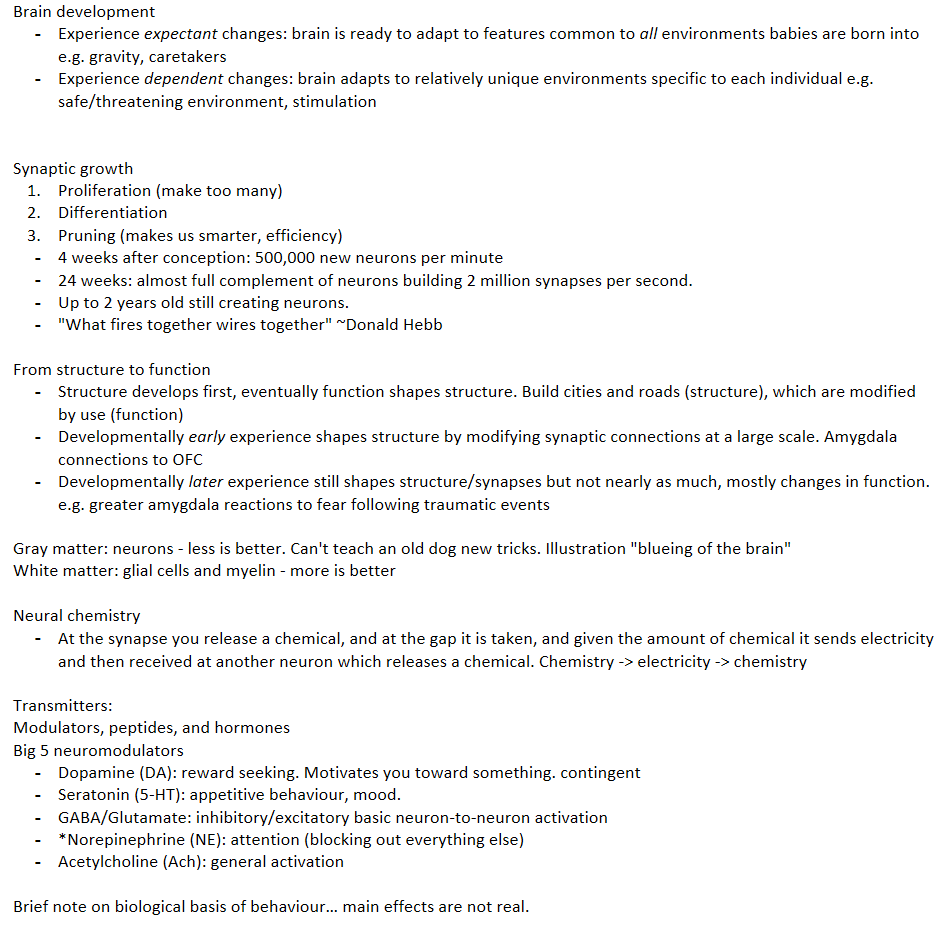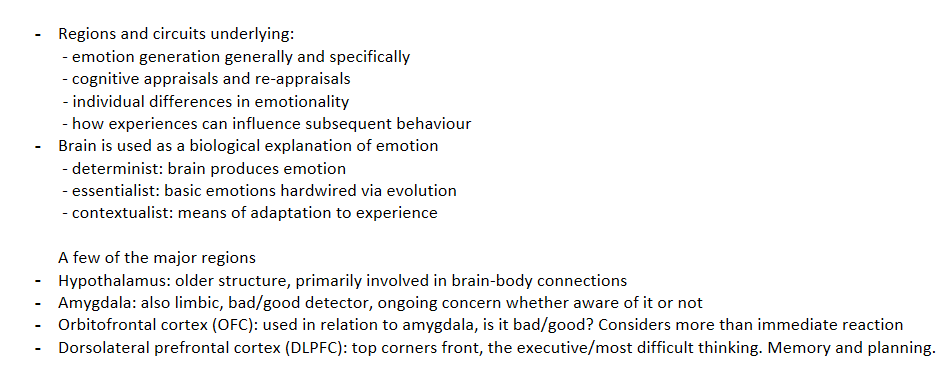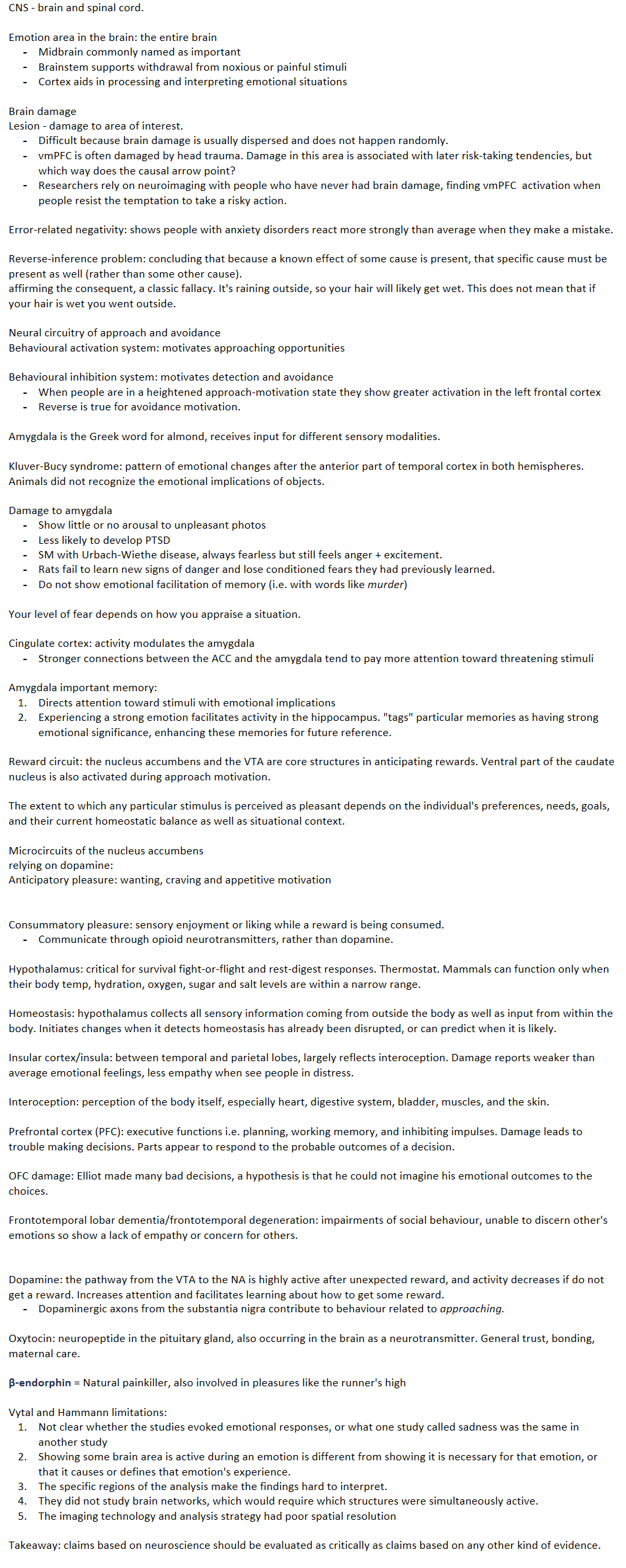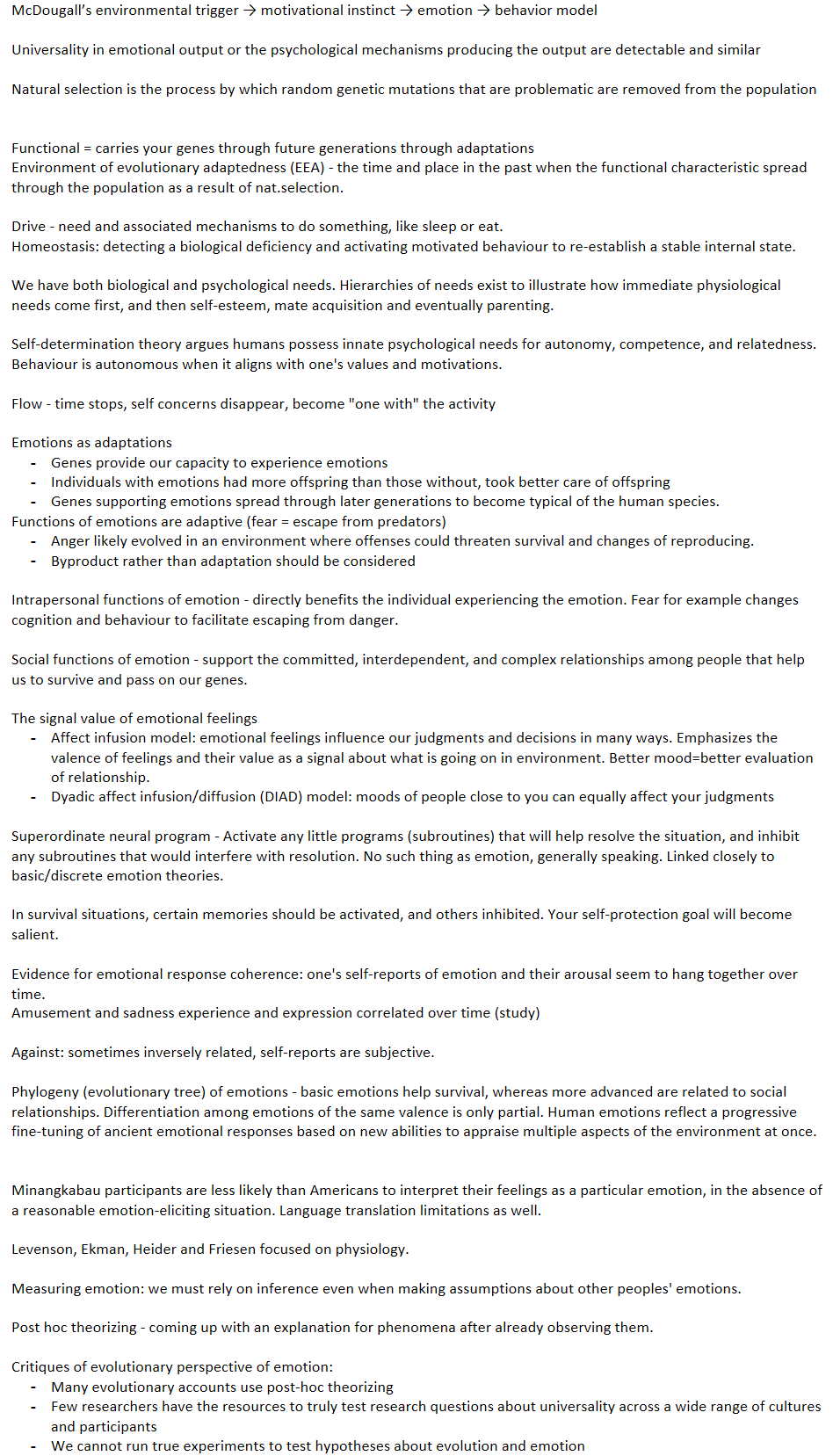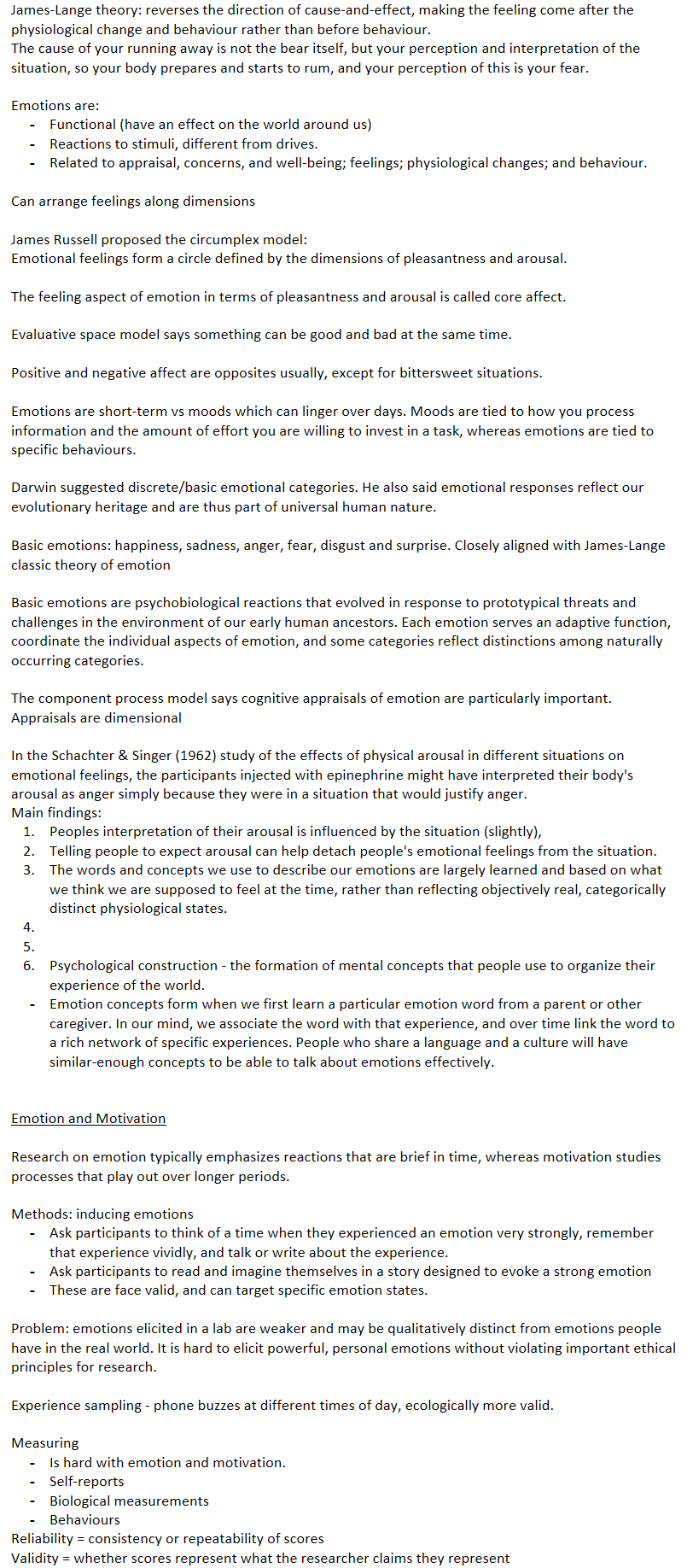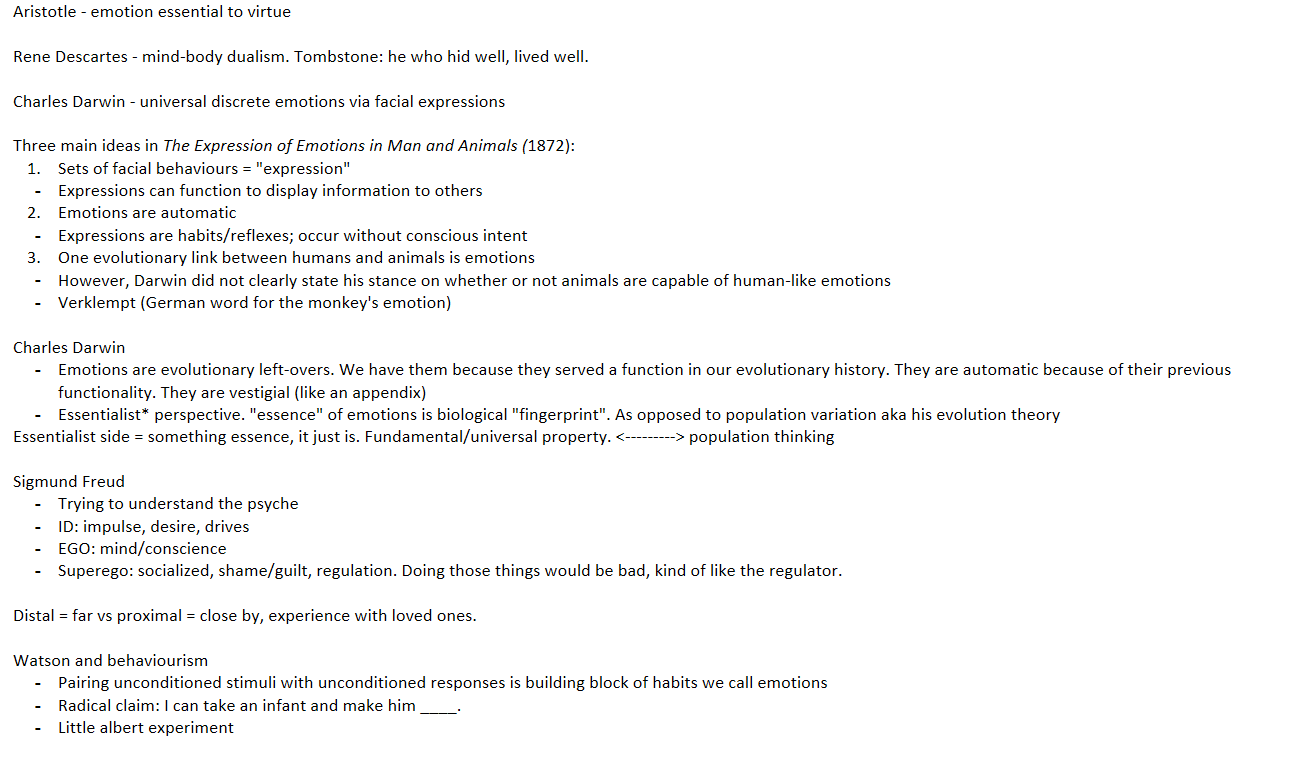psyc 351 midterm
Focus on three emotions
Anxiety
Shame
Positive emotions
Contrasting essentialism and constructivism
Essentialism is biological determinism.
Constructivism says adaptations come from experience. Sometimes called behaviourism or radical constructivism.
Temperament is related to someone's nature, whereas attachment is more nurture.
Emotion regulation is a combination of both temperament and attachment & relationships. This is functionalism and neural constructivism.
Part 1: emotion
History and evolution
Biology: brain and body
Emotion expression
Aristotle - emotion essential to virtue
Rene Descartes - mind-body dualism. Tombstone: he who hid well, lived well.
Charles Darwin - universal discrete emotions via facial expressions
Three main ideas in The Expression of Emotions in Man and Animals (1872):
Sets of facial behaviours = "expression"
Expressions can function to display information to others
Emotions are automatic
Expressions are habits/reflexes; occur without conscious intent
One evolutionary link between humans and animals is emotions
However, Darwin did not clearly state his stance on whether or not animals are capable of human-like emotions
Verklempt (German word for the monkey's emotion)
Charles Darwin
Emotions are evolutionary left-overs. We have them because they served a function in our evolutionary history. They are automatic because of their previous functionality. They are vestigial (like an appendix)
Essentialist* perspective. "essence" of emotions is biological "fingerprint". As opposed to population variation aka his evolution theory
Essentialist side = something essence, it just is. Fundamental/universal property. <---------> population thinking
Sigmund Freud
Trying to understand the psyche
ID: impulse, desire, drives
EGO: mind/conscience
Superego: socialized, shame/guilt, regulation. Doing those things would be bad, kind of like the regulator.
Distal = far vs proximal = close by, experience with loved ones.
Watson and behaviourism
Pairing unconditioned stimuli with unconditioned responses is building block of habits we call emotions
Radical claim: I can take an infant and make him ____.
Little albert experiment
James-Lange: feedback from physical experiences produce emotions
Event -> physical response.
James said each instance of emotion (not each type) comes from a unique bodily state.
Cannon-Bard: components of emotion occur independently
Schachter-Singer
Two-factor theory: physiological arousal determines intensity but not specific emotional state.
People use context and other cues to differentiate which emotional state they are experiencing.
Preview: contemporary themes and issues
Emotion as a Latent process: emotion causes physiological arousal, expression, and cognition outputs
James-Lange theory: reverses the direction of cause-and-effect, making the feeling come after the physiological change and behaviour rather than before behaviour.
The cause of your running away is not the bear itself, but your perception and interpretation of the situation, so your body prepares and starts to rum, and your perception of this is your fear.
Emotions are:
Functional (have an effect on the world around us)
Reactions to stimuli, different from drives.
Related to appraisal, concerns, and well-being; feelings; physiological changes; and behaviour.
Can arrange feelings along dimensions
James Russell proposed the circumplex model:
Emotional feelings form a circle defined by the dimensions of pleasantness and arousal.
The feeling aspect of emotion in terms of pleasantness and arousal is called core affect.
Evaluative space model says something can be good and bad at the same time.
Positive and negative affect are opposites usually, except for bittersweet situations.
Emotions are short-term vs moods which can linger over days. Moods are tied to how you process information and the amount of effort you are willing to invest in a task, whereas emotions are tied to specific behaviours.
Darwin suggested discrete/basic emotional categories. He also said emotional responses reflect our evolutionary heritage and are thus part of universal human nature.
Basic emotions: happiness, sadness, anger, fear, disgust and surprise. Closely aligned with James-Lange classic theory of emotion
Basic emotions are psychobiological reactions that evolved in response to prototypical threats and challenges in the environment of our early human ancestors. Each emotion serves an adaptive function, coordinate the individual aspects of emotion, and some categories reflect distinctions among naturally occurring categories.
The component process model says cognitive appraisals of emotion are particularly important. Appraisals are dimensional
In the Schachter & Singer (1962) study of the effects of physical arousal in different situations on emotional feelings, the participants injected with epinephrine might have interpreted their body's arousal as anger simply because they were in a situation that would justify anger.
Main findings:
Peoples interpretation of their arousal is influenced by the situation (slightly),
Telling people to expect arousal can help detach people's emotional feelings from the situation.
The words and concepts we use to describe our emotions are largely learned and based on what we think we are supposed to feel at the time, rather than reflecting objectively real, categorically distinct physiological states.
Psychological construction - the formation of mental concepts that people use to organize their experience of the world.
Emotion concepts form when we first learn a particular emotion word from a parent or other caregiver. In our mind, we associate the word with that experience, and over time link the word to a rich network of specific experiences. People who share a language and a culture will have similar-enough concepts to be able to talk about emotions effectively.
Emotion and Motivation
Research on emotion typically emphasizes reactions that are brief in time, whereas motivation studies processes that play out over longer periods.
Methods: inducing emotions
Ask participants to think of a time when they experienced an emotion very strongly, remember that experience vividly, and talk or write about the experience.
Ask participants to read and imagine themselves in a story designed to evoke a strong emotion
These are face valid, and can target specific emotion states.
Problem: emotions elicited in a lab are weaker and may be qualitatively distinct from emotions people have in the real world. It is hard to elicit powerful, personal emotions without violating important ethical principles for research.
Experience sampling - phone buzzes at different times of day, ecologically more valid.
Measuring
Is hard with emotion and motivation.
Self-reports
Biological measurements
Behaviours
Reliability = consistency or repeatability of scores
Validity = whether scores represent what the researcher claims they represent
McDougall’s environmental trigger → motivational instinct → emotion → behavior model
Universality in emotional output or the psychological mechanisms producing the output are detectable and similar
Natural selection is the process by which random genetic mutations that are problematic are removed from the population
Functional = carries your genes through future generations through adaptations
Environment of evolutionary adaptedness (EEA) - the time and place in the past when the functional characteristic spread through the population as a result of nat.selection.
Drive - need and associated mechanisms to do something, like sleep or eat.
Homeostasis: detecting a biological deficiency and activating motivated behaviour to re-establish a stable internal state.
We have both biological and psychological needs. Hierarchies of needs exist to illustrate how immediate physiological needs come first, and then self-esteem, mate acquisition and eventually parenting.
Self-determination theory argues humans possess innate psychological needs for autonomy, competence, and relatedness. Behaviour is autonomous when it aligns with one's values and motivations.
Flow - time stops, self concerns disappear, become "one with" the activity
Emotions as adaptations
Genes provide our capacity to experience emotions
Individuals with emotions had more offspring than those without, took better care of offspring
Genes supporting emotions spread through later generations to become typical of the human species.
Functions of emotions are adaptive (fear = escape from predators)
Anger likely evolved in an environment where offenses could threaten survival and changes of reproducing.
Byproduct rather than adaptation should be considered
Intrapersonal functions of emotion - directly benefits the individual experiencing the emotion. Fear for example changes cognition and behaviour to facilitate escaping from danger.
Social functions of emotion - support the committed, interdependent, and complex relationships among people that help us to survive and pass on our genes.
The signal value of emotional feelings
Affect infusion model: emotional feelings influence our judgments and decisions in many ways. Emphasizes the valence of feelings and their value as a signal about what is going on in environment. Better mood=better evaluation of relationship.
Dyadic affect infusion/diffusion (DIAD) model: moods of people close to you can equally affect your judgments
Superordinate neural program - Activate any little programs (subroutines) that will help resolve the situation, and inhibit any subroutines that would interfere with resolution. No such thing as emotion, generally speaking. Linked closely to basic/discrete emotion theories.
In survival situations, certain memories should be activated, and others inhibited. Your self-protection goal will become salient.
Evidence for emotional response coherence: one's self-reports of emotion and their arousal seem to hang together over time.
Amusement and sadness experience and expression correlated over time (study)
Against: sometimes inversely related, self-reports are subjective.
Phylogeny (evolutionary tree) of emotions - basic emotions help survival, whereas more advanced are related to social relationships. Differentiation among emotions of the same valence is only partial. Human emotions reflect a progressive fine-tuning of ancient emotional responses based on new abilities to appraise multiple aspects of the environment at once.
Minangkabau participants are less likely than Americans to interpret their feelings as a particular emotion, in the absence of a reasonable emotion-eliciting situation. Language translation limitations as well.
Levenson, Ekman, Heider and Friesen focused on physiology.
Measuring emotion: we must rely on inference even when making assumptions about other peoples' emotions.
Post hoc theorizing - coming up with an explanation for phenomena after already observing them.
Critiques of evolutionary perspective of emotion:
Many evolutionary accounts use post-hoc theorizing
Few researchers have the resources to truly test research questions about universality across a wide range of cultures and participants
We cannot run true experiments to test hypotheses about evolution and emotion
CNS - brain and spinal cord.
Emotion area in the brain: the entire brain
Midbrain commonly named as important
Brainstem supports withdrawal from noxious or painful stimuli
Cortex aids in processing and interpreting emotional situations
Brain damage
Lesion - damage to area of interest.
Difficult because brain damage is usually dispersed and does not happen randomly.
vmPFC is often damaged by head trauma. Damage in this area is associated with later risk-taking tendencies, but which way does the causal arrow point?
Researchers rely on neuroimaging with people who have never had brain damage, finding vmPFC activation when people resist the temptation to take a risky action.
Error-related negativity: shows people with anxiety disorders react more strongly than average when they make a mistake.
Reverse-inference problem: concluding that because a known effect of some cause is present, that specific cause must be present as well (rather than some other cause).
affirming the consequent, a classic fallacy. It's raining outside, so your hair will likely get wet. This does not mean that if your hair is wet you went outside.
Neural circuitry of approach and avoidance
Behavioural activation system: motivates approaching opportunities
Behavioural inhibition system: motivates detection and avoidance
When people are in a heightened approach-motivation state they show greater activation in the left frontal cortex
Reverse is true for avoidance motivation.
Amygdala is the Greek word for almond, receives input for different sensory modalities.
Kluver-Bucy syndrome: pattern of emotional changes after the anterior part of temporal cortex in both hemispheres. Animals did not recognize the emotional implications of objects.
Damage to amygdala
Show little or no arousal to unpleasant photos
Less likely to develop PTSD
SM with Urbach-Wiethe disease, always fearless but still feels anger + excitement.
Rats fail to learn new signs of danger and lose conditioned fears they had previously learned.
Do not show emotional facilitation of memory (i.e. with words like murder)
Your level of fear depends on how you appraise a situation.
Cingulate cortex: activity modulates the amygdala
Stronger connections between the ACC and the amygdala tend to pay more attention toward threatening stimuli
Amygdala important memory:
Directs attention toward stimuli with emotional implications
Experiencing a strong emotion facilitates activity in the hippocampus. "tags" particular memories as having strong emotional significance, enhancing these memories for future reference.
Reward circuit: the nucleus accumbens and the VTA are core structures in anticipating rewards. Ventral part of the caudate nucleus is also activated during approach motivation.
The extent to which any particular stimulus is perceived as pleasant depends on the individual's preferences, needs, goals, and their current homeostatic balance as well as situational context.
Microcircuits of the nucleus accumbens
relying on dopamine:
Anticipatory pleasure: wanting, craving and appetitive motivation
Consummatory pleasure: sensory enjoyment or liking while a reward is being consumed.
Communicate through opioid neurotransmitters, rather than dopamine.
Hypothalamus: critical for survival fight-or-flight and rest-digest responses. Thermostat. Mammals can function only when their body temp, hydration, oxygen, sugar and salt levels are within a narrow range.
Homeostasis: hypothalamus collects all sensory information coming from outside the body as well as input from within the body. Initiates changes when it detects homeostasis has already been disrupted, or can predict when it is likely.
Insular cortex/insula: between temporal and parietal lobes, largely reflects interoception. Damage reports weaker than average emotional feelings, less empathy when see people in distress.
Interoception: perception of the body itself, especially heart, digestive system, bladder, muscles, and the skin.
Prefrontal cortex (PFC): executive functions i.e. planning, working memory, and inhibiting impulses. Damage leads to trouble making decisions. Parts appear to respond to the probable outcomes of a decision.
OFC damage: Elliot made many bad decisions, a hypothesis is that he could not imagine his emotional outcomes to the choices.
Frontotemporal lobar dementia/frontotemporal degeneration: impairments of social behaviour, unable to discern other's emotions so show a lack of empathy or concern for others.
Dopamine: the pathway from the VTA to the NA is highly active after unexpected reward, and activity decreases if do not get a reward. Increases attention and facilitates learning about how to get some reward.
Dopaminergic axons from the substantia nigra contribute to behaviour related to approaching.
Oxytocin: neuropeptide in the pituitary gland, also occurring in the brain as a neurotransmitter. General trust, bonding, maternal care.
β-endorphin = Natural painkiller, also involved in pleasures like the runner's high
Vytal and Hammann limitations:
Not clear whether the studies evoked emotional responses, or what one study called sadness was the same in another study
Showing some brain area is active during an emotion is different from showing it is necessary for that emotion, or that it causes or defines that emotion's experience.
The specific regions of the analysis make the findings hard to interpret.
They did not study brain networks, which would require which structures were simultaneously active.
The imaging technology and analysis strategy had poor spatial resolution
Takeaway: claims based on neuroscience should be evaluated as critically as claims based on any other kind of evidence.
Regions and circuits underlying:
- emotion generation generally and specifically
- cognitive appraisals and re-appraisals
- individual differences in emotionality
- how experiences can influence subsequent behaviour
Brain is used as a biological explanation of emotion
- determinist: brain produces emotion
- essentialist: basic emotions hardwired via evolution
- contextualist: means of adaptation to experience
A few of the major regions
Hypothalamus: older structure, primarily involved in brain-body connections
Amygdala: also limbic, bad/good detector, ongoing concern whether aware of it or not
Orbitofrontal cortex (OFC): used in relation to amygdala, is it bad/good? Considers more than immediate reaction
Dorsolateral prefrontal cortex (DLPFC): top corners front, the executive/most difficult thinking. Memory and planning.
Amygdala and hypothalamus
"freedom from the tyranny of the hypothalamus" (Mesalum)
But every structure in limbic system is designed to tell hypothalamus what to do (and only one signal at a time, all other signals inhibited)
Some plasticity
Slows down responses - maintain attentional focus. Extends our awareness in time. Ability to do more than react.
Paleomammalian - og mammals: vocal signals, attachment, juvenile play.
Hypothalamus
Coordinates "internal milieu" (~Claude Bernard)
Major brain-body connections
Autonomic nervous system, HPA and HPG axis (hormones)
Produces neuropeptides… oxytocin (care/nurturance), vasopressin (aggression, territorial)
And neurohormones (hypothalamus and pituitary)
Corticotropin releasing hormone
Luteinizing releasing hormone
Amygdala - bad/good machine
Attaches emotional significance (appraisals) to stimuli automatically
Appraisals - what does x mean? X being any stimulus
Binary, stimulus-response type of activation
Develops early - not very plastic.
Fear, emotion generation
The frontal cortex
Time: slows down, past, and future. Further slowing down time.
Regulation - steer impulses toward achieving a goal, i.e. study when anxious for a test.
DL-PFC dorsolateral prefrontal cortex
OFC orbitofrontal cortex
ACC anterior cingulate cortex
OFC
Evaluation of emotional significance (appraisals): orients attention and action to present reinforcement contingencies (if this, then that)
Approach vs avoid - should I go up to that person?
Inhibition - not saying what comes to mind right away
Strong connections to amygdala and limbic system
PFC
Working memory - holds onto information over time, permitting manipulation, synthesis, perspective-taking (integrates long-term, complex knowledge to make connections).
Conscious control of behaviour ("cool cognition"); delay of gratification (marshmallow task with children)
Neurons connect to almost all parts of brain. Hence, integrated appraisals (using info from all regions)
Last to develop (in individuals and across evolution)
Integrated appraisals, regulation
Left vs right hemispheres: approach left, avoid right. Behavioural activation and inhibition.
Dorsal (top) vs ventral (bottom): dorsal "cool cognition", ventral "hot cognition".
Brain development
Experience expectant changes: brain is ready to adapt to features common to all environments babies are born into e.g. gravity, caretakers
Experience dependent changes: brain adapts to relatively unique environments specific to each individual e.g. safe/threatening environment, stimulation
Synaptic growth
Proliferation (make too many)
Differentiation
Pruning (makes us smarter, efficiency)
4 weeks after conception: 500,000 new neurons per minute
24 weeks: almost full complement of neurons building 2 million synapses per second.
Up to 2 years old still creating neurons.
"What fires together wires together" ~Donald Hebb
From structure to function
Structure develops first, eventually function shapes structure. Build cities and roads (structure), which are modified by use (function)
Developmentally early experience shapes structure by modifying synaptic connections at a large scale. Amygdala connections to OFC
Developmentally later experience still shapes structure/synapses but not nearly as much, mostly changes in function. e.g. greater amygdala reactions to fear following traumatic events
Gray matter: neurons - less is better. Can't teach an old dog new tricks. Illustration "blueing of the brain"
White matter: glial cells and myelin - more is better
Neural chemistry
At the synapse you release a chemical, and at the gap it is taken, and given the amount of chemical it sends electricity and then received at another neuron which releases a chemical. Chemistry -> electricity -> chemistry
Transmitters:
Modulators, peptides, and hormones
Big 5 neuromodulators
Dopamine (DA): reward seeking. Motivates you toward something. contingent
Seratonin (5-HT): appetitive behaviour, mood.
GABA/Glutamate: inhibitory/excitatory basic neuron-to-neuron activation
*Norepinephrine (NE): attention (blocking out everything else)
Acetylcholine (Ach): general activation
Brief note on biological basis of behaviour… main effects are not real.
Tinbergen (evolutionary biologist)
Development - about an individual
Evolution - populations of individuals
With both, there are questions of causation.
Tinbergen's 4 questions
Proximate cause
Ultimate cause
How?
Development
How did it develop during an individual's lifetime?
Evolution
How did it evolve over the history of the species?
Why?
Causation
What makes it work?
Function - what is it for?
Proximal = in immediate environment
Ultimate = distal, for the species.
The survival of the collective is served by emotions
Selection pressures for things that are common for a species.
Ester Thelen said "what develops is what works". Functionally it provided goal achievement or progress.
What is evolution?
Any change in the heritable traits within a population across generations
Can be random (e.g. mutations)
In times of environmental stability, there is a lot of variability.
Can be guided by natural selection
Effectiveness of a trait in enabling organisms to adapt to changing environmental conditions
Adaptive significance:
The adaptiveness of a trait depends on how well it solves an evolutionary problem, or struggle (survival and reproduction)
Natural selection
Individual differences in physical and behavioural characteristics among organisms of the same species. (e.g. some humans more aggressive than others)
There are "struggles for life" (survival or mates) at some point in the life span (hard environmental conditions)
Individual differences in physical and behavioural characteristics must confer advantages for survival (tendencies to be more or less aggressive must have some advantage)
The individuals that survive to reproduce will pass along their characteristics to their offspring (if aggression is favourable in some environment, individuals with that trait will survive and their kids will have it)
Individual vs group
Short-term vs long-term
Is it adaptive?
Darwin thought emotions used to be adaptive and they are not necessary
Is it a byproduct?
Parasympathetic - digestion
Sympathetic - running away from a threat
Zebras don't get ulcers - their sympathetic reactions are short-lived.
We have evolved to live in conditions of chronic threat. Stress.
Cosmides and Tooby
Environment of evolutionary adaptiveness (EEA) - the time and place in the past when the functional characteristic spread through the population as a result of natural selection.
“statistical composite of selection pressures that caused the genes
underlying the design of an adaptation to increase in frequency until they
became species-typical or stably persistent”
Map on computing constructs in relation to the brain. It's like a computer program
Emotions are domain-specific "programs" for solving adaptive problems:
Face recognition
Foraging
Mate choice
Autonomic regulation
Sleep management
Predator vigilance
Emotion is a superordinate program coordinating many subprograms
Each emotion entrains subordinate programs in response to triggering conditions that:
Recurred ancestrally
Required superordinate program (no conflict among subprograms) - we needed something to coordinate the other programs.
Have a rich and reliable repeated structure - consistent across a species
Signal their presence with recognizable cues
Potentially result in large fitness costs (fitness for survival)
Match the emotion to its evolutionary function
1 anger - overcome injustice
2 fear - increase attention to environment
3 guilt - maintain social relationships
4 sadness - elicit interpersonal support
5 disgust - avoid harmful substances and people
Autonomic nervous system
Important for emotion, as it situates a lot of the visceral feelings.
States of arousal
Consists of two chains of neurons alongside the spinal cord with connections to major organs
Both input and output functions
Sympathetic prepares the body for intense muscular action
Parasympathetic facilitates digestion, growth, and reproduction
Peristalsis: smooth muscles in intestines stop pulsing, keeping food in right direction.
When pupils dilate, the sympathetic nervous system is activated. Signals fear and love.
Sympathetic : neurons leading to different organs travel alongside each other for long distances, and synapses connecting different neurons are typically clustered together.
Dilate pupils
Accelerate heart
Inhibit intestinal movement
Contract sphincters
Parasympathetic : neurons split off and head for different organs closer to the spinal cord. Calm, vegetative functions.
Heart rate: both sympathetic (electrodermal activity, measures changes in sweat on fingertips) and parasympathetic (respiratory sinus arrythmia). Without PSN, HR = 100+bpm, it is holding it down. Deceleration = external attention, first response to event (oh no). Acceleration = internal attention, sustained response (I'm outta here)
INTERBEAT INTERVAL (IBI) - INVERSE HEARTBEAT: smaller people tend to have faster heartrates than adults.
Electrodermal activity: non-invasive; high temporal resolution. Sweat happens very quickly. Disadvantages: non-specific (cannot use in isolation, you are feeling x)
Vagal tone/Respiratory Sinus Arrhythmia: parasympathetic (regulatory) reactive. RSA (during exhalation rate slows, and increases during inhalation).
Two functional roles: during low stress, promote homeostasis and growth (baseline vagal tone or TONIC RSA).
High stress "vagal break" (Porges) suppressing or decreasing vagal tone (Phasic RSA).
High (tonic) baseline = I'm ready for anything. Rapid (phasic) decrease = I can deal with it. More regulatory.
Kama muta: a feeling of being moved or touched by someone's generosity or thoughtfulness
Undoing effect of positive emotion: positive emotions can help people recover after an intense negative emotion, physiologically and emotionally
General adaptation syndrome: Selye's proposal of the body's reaction to any threat, progressing through three stages
Stress (Selye): the nonspecific response of the body to any demand made on it
Hans Selye had rats and was injecting them with cortisol.
Stress is a metaphor borrowed from engineering - stress on materials. Response to pressure.
Robert Sapolsky - great example of how stress functions in animals
One baboon troupe, hierarchy with status and seniority. There was a lower status male who sat there and watched them.
Psychological stress (perceived stress) comes from:
Lack of control (rat controls shocks) it is happening to you. Getting control reduces stress.
Lack of predictability or discrepancy with expectation (novelty).
Lack of outlets for frustration
Acute stress: life or death situation, run away, sudden and urgent.
Chronic stress: continues for a prolonged period of time.
Alarm: brief period of high arousal of the sympathetic nervous system.
Resistance: body maintains prolonged but moderate arousal. Sympathetic response declines, but adrenal cortex continues secreting cortisol.
Exhaustion: weakness, fatigue, loss of appetite, and lack of motivation. More vulnerable to illness.
Hypothalamus-pituitary-adrenal (HPA) axis: composed of the hypothalamus, pituitary gland, and adrenal gland. Readies the body for physical action and emotional challenge, but its effects are slower and lasts longer.
Major substances of HPA axis
Glucocorticoids (GC)
Steroid hormones able to bind with cortisol receptor. Quick energy to do stuff
Cortisol most important
Corticotropin releasing hormone (CRH)
And other ones
Hypothalamus tells pituitary to tell adrenals to release both norepinephrine (adrenaline) and glucocorticoids (cortisol), want more energy in big muscles to fight/flight. Hypothalamus will be notified there is glucocorticoid circulated and once there is enough it levels off. ACUTE STRESSORS = good.
For chronic stress with the HPA axis, sustained release of the hormones can cause issues.
The Revised Social Readjustment Rating Scale (Hobson et al., 1998). To measure your stress level, check the events you have experienced in the past 12 months and total their point values. If total is above 145, you have had more stress than other people. It has its issues though
Greatest threats to physical and mental health derive from feelings of personal rejection, such as from a divorce or romantic break-up.
Cortisol is usually highest in the morning.
Spit measures - big advance and now hair.
Cra cortisol awakening response
Diurnal rhythm
Basal levels
Responsivity (to acute stress)
Chronic stress -> diurnal rhythm. Restricted range, elevated.
Chronic stress -> reactivity. Higher peak, slower recovery
PNS -> SNS -> HPA timing
PNS is most rapid response system
PNS withdrawal then allows for SNS activation
If PNS and SNS changes persist, then HPA kicks in, about 5 mins after triggering event. Slow response because it uses a lot of energy and costly to body.
So PNS/SNS is more related to emotion, HPA more mood.
Emotions in the body summary
Emotional processes in the body: arousal and stress
Autonomic nervous system distributes energy
Bruce McEwen says we need to focus more on how body's stress response systems become overloaded and less efficient under chronic stress.
Prolonged cortisol elevation increases metabolic rate, causing cells in the hippocampus to become more vulnerable to damage by either toxins or overstimulation (Sapolsky, 1992).
What is emotion?
Elicitor or stimulus or event
Response or action
Physiological mechanisms
Cognition and/or appraisals (ofc, evaluation)
Organization of feelings or action
Expressive behaviour
What is affect?
For some, affect is subjective feeling (Russell, 2003)
Others say it is superordinate to emotion
Me (and others): observable expression or behaviour (e.g. facial affect)
Emotion and mood differ by the time scale of their persistence.
Theoretical Approaches (that inform current developmental perspectives)
–Cognitive Appraisal (Arnold, Schachter, Lazarus)
–Neurobiological (Ekman, Panksepp, LeDoux)
–Constructivism (LF Barrett, almost everyone...)
Behaviourism: catalyst for emotion research, by cognitivists.
Appraisal theory: perception -> cognitive appraisal -> emotional response
Some acknowledged this was not just three steps but emotional response can cause new perception that can be reappraised. Ongoing process. (Magda Arnold)
Schacter and Singer revisited: cognitive appraisal of arousal. No evidence, highly disputed (e.g. Lazarus, Tomkins).
Lazarus Cognitive-Motivational-Relational
Based on cognitive coping with stress -
Acknowledges subjective experience
Core relational themes (relations with others/world):
Anger -> offense against me/mine
Fright/anxiety -> concrete/uncertain threat
Happiness -> progress toward goal
Sadness -> loss
Guilt -> one's own moral transgression
Shame -> failure to live up to (ego) ideal
Failure is worse than transgression.
Neurobiological
Core neurological circuits for fear, rage, and caregiving that evolved in early animals. Evolutionary to survive.
Still present today in humans
Limbic system and cortex just elaborate on those basic circuits.
Ekman’s Neuro-cultural Model
Culturally variable (in part) v
Elicitors (events, expectations, memories)
Facial affect (face muscles in association with happiness, disgust, anger, sadness, surprise, interest, fear.
Display rules (intensify, diminish, neutralize, mask)
Consequences (facial, motor adaptive patterns, verbal vocal, physiological.
Pancultural (i.e. universal, common to all humans) 2
Expressive suppression has consequences on a person too.
Social constructivism
Emotions are socially/culturally constructed
Radical or extreme form emerged to battle biological determinism (e.g. Mead)
Less radical form present in almost all theories of development (i.e. nurture is important)
Storm and stress: adolescents all because of hormones. Biological. Constructivists searched for places where that didn't happen. Samoa. One type of experience growing up will differ from another.
Neural constructivism
Lisa Feldman Barrett’s Theory of Constructed Emotions
• High variability across instances of specific emotion, within and across individuals, yet we categorize as same
• Brain is prediction tester with confirmation bias. (anger-jealousy blend, prediction about the components of a situation, labelling experience with learned emotion labels).
• Therefore we identify radically different reactions as the same thing (e.g., anger), children learn to categorize how their parents do. Co-construction transmitted across generations.
Context is part of the emergence. Different if something was accidental vs purposeful.
ARE EMOTIONS: DISCRETE (BASIC)? CONTINUOUS (DIMENSIONAL)? ESSENTIAL OR CONSTRUCTED? INSIDE OR OUTSIDE?
Basic: categories that are non-overlapping. There are a limited number of emotional states that occur in all humans.
Gray: hardwired
Ekman: universal facial expressions
James: bodily involvement
Arnold: appraisal theorist, relation to action tendencies.
Can modulate based on display rules but still there, it doesn’t go away.
Criteria for basic emotions (BE's)
BEs should be universal within our species
BE must facilitate a functional response to a specific, prototypical life event (does something useful)
BEs should be evident early in life
There should be an innate way of expressing the BE (i.e., face, voice)
Each BE should have its own physiological basis (identical for all instances of anger for example).
Facial Affect Coding System - FACS: changes in expression are detectable and take action units to code. Sometimes these things are confusing though.
Continuous: multidimensional, arousal (activation) and valence (pleasantness/- to +)
Russell (2003) - core affect:
A neurophysiological state that is consciously accessible as a simple, unconscious feeling that is a combo of hedonic valence (unpleasant<-->pleasant or negative<-->positive) and arousal (deactivated<-->activated or unaroused<-->aroused) values. You are somewhere in there all the time. Opposition (calm is opposite of tense. Sad vs happy). What is basic is just arousal and valence.
Peter Lang - same as Russell just tilted 90 degrees. Nothing happens at low arousal, whereas higher is where you get differentiation. Appetitive vector: sustenance, copulation, caregiving. Defensive vector: threat, withdrawal, escape, attack.
Showed people pictures corresponded with defensive motivation and appetitive motivation, and when done with words more than pictures it is even more strongly correlated.
But are there basic emotions?
Lisa Feldman Barrett says:
“classical view” (basic emotions) is essentialist, flawed. no evidence of “natural kinds” (a category of things all the same as one another and different from some other set of
things)
Offers an alternative, constructivist view based on predictive brain and how we socially construct emotion concepts..
Theory of Constructed Emotion
Emotions are concepts about affect (arousal & valence)
No biological “fingerprint” (anti-essentialist) tons of variation within category (e.g., sadness)
Your brain’s best guess (prediction) about the state of your “body budget” (of metabolic energy). Brain is constantly evaluating the amount of energy one has to expend relative to energy taking in. perception overload, economy/ efficiency. Threats can change the body budget.
Constructed from language, experience, and culture. Language is a tool of our
Regulation is also not looked at in basic emotion.
different emotion
concepts around the world
• Gigil (Filipino): The urge to hug or squeeze something that is unbearably adorable
• Voorpret (Dutch): Pleasure felt about an event before the event takes place
• Age-otori (Japanese): The feeling of looking worse after a haircut.
Inside or Outside: do emotions exist within an individual or between individuals?
MInE vs OuRS
Mentalized Inside Essentialist "I am angry"
Western Educated Industrial Rich Democratic (WEIRD) MInE.
Outside Relational Situational - collectivistic countries, context first then individual. "we have this emotion"
Emotions: are important
Have evolved for functional purposes
Arise from some combination of physiology, cognition, and behaviour
Might be hardwired but are not result of biological main effects. Socially constructed and different across cultures.
Ch 4- emotion and motivation (proximal)
Leptin: hormone that tends to reduce the sense of hunger, communicating that a good amount of energy is already stored
Ghrelin: a peptide hormone produced by the stomach, as well as some other parts of the digestive system and structures in the brain, that generally increases feelings of hunger. Increases with lack of sleep.
Rooting reflex: newborns turn their head and begin to suck when something gently touches the corner of their mouth—a response crucial for feeding
Cue reactivity: people develop conditioned responses to objects, places, and other stimuli associated with prior use of addictive drugs
Appraisal (Lazarus): what elicits an emotional response is not the objective stimulus, but our subjective interpretation of what the stimulus means for our goals, concerns, and well-being
Emotions are about our ongoing relationships with the environment
Intention may not align with appraisal from another person
Cognitive appraisal happens before physiological body reactions. Categorizes the emotional quality of a scene quickly.
Schacter and Singer: the appraisal comes after the feeling and action, or carries over from one emotional situation to another.
Rozin and Fallon: disgust is a response to anything that we perceive as a potential source of contamination, likely to make us sick.
Core relational themes (CATEGORICAL): appraisal takes the form of a basic, prototypical type of problem or benefit that people can encounter in their transactions with the environment. They reflect fundamental kinds of events humans encounter (Lazarus). Does not depend on language as they are universal.
Appraisal dimensions (CONTINUOUS): we evaluate the meaning of stimuli using a common set of criteria, rather than holding each experience up to a categorical meaning template to see whether it fits. e.g. novelty, expectedness, pleasantness, fairness, control, morality, etc.
Emotion blend: experience multiple emotions at the same time, caused by simultaneous appraisal of core relational themes
Primary appraisal: goal relevance, goal congruence, and ego-involvement. Determines one's response
Secondary appraisal: ability to cope with the situation. Involves blame or credit, coping potential, and future expectations.
Threat vs challenge condition: the body's physiological response to an event depends on how we appraise the event
Mere exposure effect: liking increased when more familiar with something.
Gender differences: women reported higher levels of fear and sadness
Cognitive-neoassociationistic (CNA) model of anger generation: any unpleasant event or sensation facilitates anger and aggressive behaviour.
Berkowitz says being too hot or anything can provoke anger, even if nobody to blame
Emotion can arise directly from an unfulfilled biological drive i.e. hunger, fatigue, without external stimulus.
There were some issues with Darwin's research
Constraining questions
Emotion and expressions were understood as the product of cultural learning
Silvan Tomkins found prototype expressions - innate
Facial Action Coding System (FACS) - assigns an action unit to the change in appearance created by moving each muscle
Ekman and colleagues' study of facial expressions of emotion in New Guinea: Found cross-cultural generality of facial expressions. New Guinea participants chose the expected facial expression as the best match for culturally-appropriate emotion stories at rates much higher than change.
Posture and emotion
Aviezer and colleagues' study of tennis players' spontaneous expressions after winning or losing a point in a match suggests that posture reliably communicate(s) the distinction between positive and negative affect.
Campos et al: posture and head movement are important for differentiating various positive emotions.
Duchenne smile: prototypical happiness
Vocal expression of emotion
Vocal bursts: wordless vocalizations such as ah or mmm intended to express a particular emotion.
There was confusion between fear and surprise, which is seen in facial expression as well.
Pride (tracy et al): raised head with lifted chin, puffed out chest, fists in the air or placed on hips
